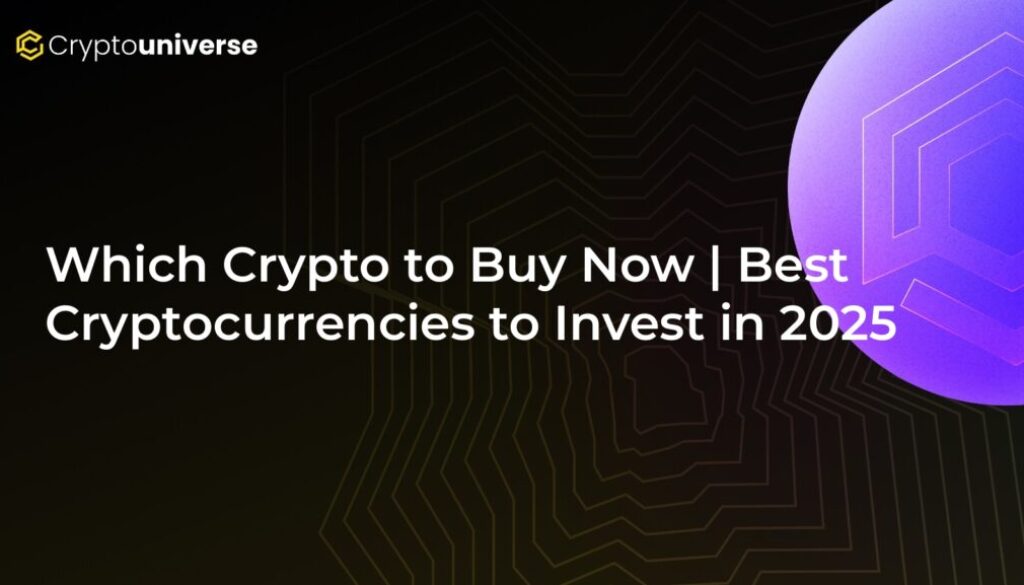Which Crypto to Buy Now | Best Cryptocurrencies to Invest in 2025

The Stage is Set: Why 2025 Could Be a Landmark Year for Crypto
The cryptocurrency market is buzzing with unprecedented excitement. With factors like the widespread adoption of Bitcoin ETFs by institutional players and a more defined regulatory landscape in the US, the foundation is being laid for what many analysts predict could be a historic bull run in 2025. The conversation has shifted from speculative curiosity to serious investment strategy.
While the market’s energy is palpable, the core question for every investor remains:
This guide will explore the
The Pillars: Blue-Chip Cryptocurrencies for Stability
Every strong portfolio needs a solid foundation. In the crypto world, that foundation is built on the most established, liquid, and widely adopted assets.
1. Bitcoin (BTC): The Original Digital Gold
Bitcoin is the undisputed king of cryptocurrency. It pioneered blockchain technology and remains the largest digital asset by market capitalization. Often called “digital gold,” its core appeal lies in its scarcity—a fixed supply of 21 million coins—making it a potential hedge against inflation for investors who are wary of the endless printing of fiat currencies.
- Why Invest? The approval of spot Bitcoin ETFs has opened the floodgates for institutional capital, lending it unprecedented legitimacy. It is the most secure and decentralized network and the most widely accepted crypto for payments.
- Things to Consider: While considered a store of value, Bitcoin is not immune to volatility. Its price can experience significant swings, and its growth potential may be less explosive compared to smaller, emerging projects.
2. Ethereum (ETH): The Smart Contract Powerhouse
If Bitcoin is digital gold, Ethereum is the decentralized internet’s engine. Its innovation lies in smart contracts—self-executing contracts with the terms of the agreement directly written into code. This technology powers the vast majority of the DeFi, NFT, and GameFi ecosystems.
- Why Invest? Ethereum’s transition to a Proof-of-Stake (PoS) consensus mechanism has made it more energy-efficient and allows ETH holders to earn rewards through staking. Its robust developer community and the growth of Layer-2 scaling solutions like Arbitrum and Optimism continue to drive its adoption. The recent approval of Ethereum ETFs further solidifies its institutional appeal.
- Things to Consider: Ethereum has faced challenges with high transaction fees (gas fees) during peak usage, though Layer-2s are actively solving this. It also faces stiff competition from other Layer-1 blockchains.
High-Growth Contenders: Top Altcoins to Watch in 2025
Beyond the giants, a universe of alternative coins (altcoins) offers specialized use cases and potentially higher returns. Here are some of the most promising narratives and projects for 2025.
1. Layer-1 Challengers: Building a Faster Future
Solana (SOL)
Known for its lightning-fast transaction speeds and low costs, Solana has emerged as a top contender to Ethereum. It has a thriving ecosystem, particularly in the realm of NFTs, gaming, and memecoins, which have brought significant attention and liquidity to the network.
- Why Invest? Solana boasts one of the fastest-growing developer communities. Its ability to handle massive transaction volumes makes it ideal for high-throughput applications. Rumors of a potential Solana ETF could also be a major price catalyst.
- Things to Consider: The Solana network has experienced several high-profile outages in the past, raising concerns about its stability and decentralization.
2. The AI Revolution: Merging AI and Blockchain
Render (RNDR)
As the AI industry explodes, the demand for GPU computing power has skyrocketed. Render is a decentralized marketplace for GPU power, allowing artists, developers, and AI companies to tap into a global network of idle processing power. This creates a direct, tangible link between the growth of AI and the value of the RNDR token.
- Why Invest? Render is a clear leader in the AI and DePIN (Decentralized Physical Infrastructure Networks) narratives. Its real-world utility in a rapidly growing sector gives it immense potential.
- Things to Consider: Its success is closely tied to the continued growth and adoption of AI and GPU-intensive rendering, making it a focused bet on that specific sector.
3. Real-World Integration: Connecting Blockchains
Chainlink (LINK)
For smart contracts to be truly useful, they need reliable, real-world data (e.g., price feeds, weather data, election results). Chainlink is the industry-standard decentralized oracle network that provides this crucial link. It is the essential middleware connecting blockchains to external systems, making it a cornerstone of the DeFi and Real-World Asset (RWA) tokenization movements.
- Why Invest? Chainlink is deeply integrated into nearly every major DeFi protocol. Its partnerships with global financial giants like SWIFT signal its potential to bridge traditional finance with the blockchain world.
- Things to Consider: As a foundational piece of infrastructure, its growth is tied to the overall health and expansion of the smart contract ecosystem.
4. The Memecoin Factor: High-Risk, High-Reward Culture
No discussion of the current crypto landscape is complete without mentioning memecoins. While they often lack fundamental utility and are driven by hype and community sentiment, they have proven to be some of the most explosive assets in this market cycle. Projects like Pepe (PEPE) and Brett (BRETT) on the Base chain have delivered staggering returns.
- Why Invest? For speculative investors with a high-risk tolerance, a small allocation to a trending memecoin can offer asymmetric upside potential.
- Things to Consider: This is the most volatile and risky category of crypto. Prices are driven by social media trends and can collapse as quickly as they rise. Invest only what you are fully prepared to lose.
How to Choose the Right Crypto for You
Navigating the crypto market requires a clear strategy. Here’s how to approach your research:
- Analyze the Use Case: Does the project solve a real problem? A strong use case and clear utility are often indicators of long-term potential.
- Check the Tokenomics: Look at the total supply, circulating supply, and distribution schedule. Is the token inflationary or deflationary? Understanding these factors is crucial to assessing its future value.
- Evaluate the Team and Community: A transparent, experienced development team and a strong, engaged community are vital signs of a healthy project.
- Assess Market Cap and Liquidity: Large-cap coins (like BTC and ETH) are generally more stable, while small-cap coins offer higher growth potential but come with greater risk and volatility.
Where to Buy Cryptocurrency
Getting started is easier than ever. Here are the main platforms:
- Centralized Exchanges (CEXs): Platforms like Coinbase, Binance, and Kraken are user-friendly and offer a wide selection of coins. They are a great starting point for beginners.
- Decentralized Exchanges (DEXs): Platforms like Uniswap and SushiSwap offer access to a broader range of newer, smaller tokens. They require a self-custody wallet (like MetaMask or Trust Wallet) and are better suited for more experienced users.
- Brokerage Apps: Fintech apps like Robinhood, eToro, and Revolut are increasingly offering crypto trading, providing a familiar interface for those who have traded stocks.
Frequently Asked Questions (FAQ)
What is the best crypto to buy for a beginner?
For beginners, it’s generally recommended to start with the most established cryptocurrencies like Bitcoin (BTC) and Ethereum (ETH). They have the longest track records, high liquidity, and a wealth of information available for research.
Which cryptocurrency has the most potential in 2025?
This depends on the narrative. For stability and institutional adoption, BTC and ETH lead the way. For high growth, many are looking at sectors like AI (RNDR), Layer-1s (SOL), and infrastructure (LINK). The highest potential often comes with the highest risk.
How much should I invest in crypto?
The golden rule of crypto investing is to never invest more than you can afford to lose. For most people, a small percentage of their overall investment portfolio (1-5%) is a sensible starting point. You can always adjust your allocation as you become more comfortable with the market.


